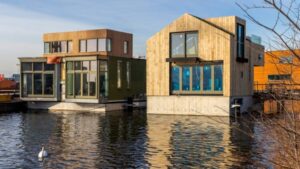
The Netherlands is leading a transformative approach to housing with the construction of floating homes designed to adapt to rising water levels and flooding. This innovative solution addresses the growing threats posed by climate change, showcasing a shift from traditional flood defenses to adaptive architecture that embraces the challenges of living with water.
In a country where nearly two-thirds of the land is vulnerable to flooding, the concept of floating and amphibious houses has emerged as a practical response. The Climate-ADAPT report from the European Environment Agency (EEA) confirms the effectiveness of these structures in managing flood risks. A notable demonstration of this concept occurred during the flooding of the Maas River in 2011, where homes seamlessly rose and settled back without sustaining any damage.
Transforming Urban Spaces
The floating neighborhood of Schoonschip in Amsterdam represents a significant step forward in this architectural revolution. More than 200 homes have been completed by the firm Waterstudio, illustrating a commitment to utilizing water surfaces for residential development. As global discussions about climate adaptation intensify, particularly at forums like COP30 in Brazil, the Dutch model is gaining attention as a viable blueprint for the future.
The design philosophy behind amphibious houses centers on engineering that allows these structures to move with rising water levels. Anchored to a land base, they can shift vertically along guide posts, adapting to changing conditions. This approach not only protects property but also enhances the livability of areas prone to flooding.
According to the EEA’s Climate-ADAPT database, floating and amphibious homes are highly effective in coping with floods. The evidence from the 2011 Maas River flooding supports this assertion, showcasing how these innovative designs can withstand extreme weather events with minimal impact.
Why the Netherlands Leads This Initiative
Several factors contribute to the Netherlands’ position as a testing ground for floating architecture:
1. **Demographic Pressure**: The nation’s densely populated cities, filled with canals, face a scarcity of solid land. Utilizing water surfaces for housing has become an attractive solution.
2. **Heritage of Water Engineering**: The Dutch have a long history of effective water management, equipping architects and engineers with the necessary expertise to develop complex adaptation solutions.
3. **Global Need**: As climate change increases the risks associated with rising sea levels and flooding, there is a growing demand for housing solutions that prioritize adaptation over traditional resilience.
While the advantages of floating homes are clear—flexibility, adaptability, and efficient urban space usage—expanding this concept globally presents challenges. Connectivity to essential services, such as public utilities and sewage systems, is more complex for floating structures than for conventional buildings. Additionally, existing building codes tend to favor fixed structures, necessitating a reevaluation of regulatory frameworks.
The export of the Dutch model also raises concerns regarding construction costs, local regulation adaptation, and potential impacts on aquatic ecosystems. As discussions at COP30 continue to emphasize adaptation strategies, the Netherlands’ experiment serves as a critical example of how communities can learn to coexist with water rather than resist it.
The future of housing in flood-prone regions may well depend on the lessons learned from this innovative approach, illustrating the potential for communities to thrive in harmony with their natural environments.







